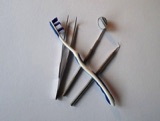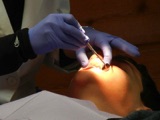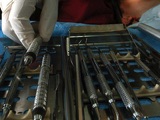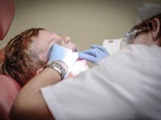







History of floss:
Toothbrushes:
From prehistoric humans to today’s modern materials, floss has truly come a long way. So, without further ado, let’s jump right into the timeline of floss. It just might make you appreciate the stuff more during your next time in the bathroom.
Before Dispenser Boxes, There Were Horses
We still don’t know when floss was first used, but scientists do have evidence that floss existed in prehistoric times. Ancient remains have been found with grooves worn in between their teeth, suggesting the regular use of floss and toothpicks. It’s widely accepted that horse hair was used as the first type of dental floss. Horse’s hair was also used as bristles in early toothbrushes! Along with chewsticks, anthropologists have discovered ancient remains of small, sharpened sticks believed to be used for interdental cleaning (between the teeth). In fact, some chewsticks had sharpened points on one end, making it a double sided oral health tool! These early toothpicks set the precedent for later devices used for interdental cleaning
The Early 19th Century – An American Dentist
History of Toothbrushes
Toothbrushing tools date back to 3500-3000 BC when the Babylonians and the Egyptians made a brush by fraying the end of a twig. Tombs of the ancient Egyptians have been found containing toothsticks alongside their owners. Around 1600BC, the Chinese developed "chewing sticks" which were made from aromatic tree twigs to freshen breath.
The Chinese are believed to have invented the first natural bristle toothbrush made from the bristles from pigs' necks in the 15th century, with the bristles attached to a bone or bamboo handle. When it was brought from China to Europe, this design was adapted and often used softer horsehairs which many Europeans preferred. Other designs in Europe used feathers.
The first toothbrush of a more modern design was made by William Addis in England around 1780 – the handle was carved from cattle bone and the brush portion was still made from swine bristles. In 1844, the first 3-row bristle brush was designed.
It wasn’t until about 1815 that floss started to have more dedicated research and development. An American dentist by the name of Dr. Levi Spear Parmly introduced the idea of using waxed silken thread to remove plaque and food debris after brushing. Waxed silken thread was readily available to consumers as tailoring thread. He eventually published a book titled A Practical Guide to the Management of Teeth, which which encouraged people to brush twice per day, and floss once every day. Which discussed how brushing and flossing daily could make a big difference in your oral health. For context, the American Dental Association wasn’t even established until 1859.
The Late 19th Century – The First Patent
In 1882, unwaxed silk floss was mass produced by the Codman and Shurtleff Company to be used expressly as dental floss. In 1898, Johnson & Johnson patented dental floss, and began producing different types of waxed and unwaxed dental floss. Johnson & Johnson’s patent was filed for the same silk material used by doctors to apply stitches.
Natural bristles were the only source of bristles until Du Pont invented nylon. The invention of nylon started the development of the truly modern toothbrush in 1938, and by the 1950s softer nylon bristles were being made, as people preferred these. The first electric toothbrush was made in 1939 and the first electric toothbrush in the US was the Broxodent in 1960.
Today, both manual and electric toothbrushes come in many shapes and sizes and are typically made of plastic molded handles and nylon bristles. The most recent toothbrush models include handles that are straight, angled, curved, and contoured with grips and soft rubber areas to make them easier to hold and use. Toothbrush bristles are usually synthetic and range from very soft to soft in texture, although harder bristle versions are available. Toothbrush heads range from very small for young children to larger sizes for older children and adults and come in a variety of shapes such as rectangular, oblong, oval and almost round.
Mid-20th Century – Times of War
During the height of World War II, the price for silk skyrocketed. As the price of silk soared, dental silken dental floss became too expensive to produce and sell, so silk was replaced with nylon. The idea to replace silk came from a dentist by the name of Dr. Charles Bass, often referred to as the “father of preventative dentistry.” Dr. Bass earned this name because of his insistence upon brushing twice per day, and flossing once every day – advice that he adopted from Dr. Levi Parmly.
The 80s
To make removing floss easier, the first interdental toothbrush was developed. To this day, people still use it to clean hard-to-reach areas of their mouth.
Present Day modern dental floss for all teeth
Today, dental floss is available in a variety of sizes, materials and flavors. You can buy dental tape to use on young gums, or even porous floss or floss made from Gore Tex rubber. Floss has come a long way since the silken thread versions of the 19th century. Now, there are versions of floss available for mouths of all shapes and sizes:
• Spongy floss
• Soft floss (for sensitive gums)
• Floss picks (for on-the-go use)
• Gore-Tex floss
• Flavored floss
Without floss, we wouldn’t be able to protect our teeth as well as we could!
History of Toothpastes:
History of Toothpastes
Egyptians are believed to have started using a paste to clean their teeth around 5000BC, before toothbrushes were invented. Ancient Greeks and Romans are known to have used toothpastes , and people in China and India first used toothpaste around 500BC.
Ancient toothpastes were used to treat some of the same concerns that we have today – keeping teeth and gums clean, whitening teeth and freshening breath. The ingredients of ancient toothpastes were however very different and varied. Ingredients used included a powder of ox hooves' ashes and burnt eggshells, that was combined with pumice. The Greeks and Romans favored more abrasiveness and their toothpaste ingredients included crushed bones and oyster shells. The Romans added more flavoring to help with bad breath, as well as powdered charcoal and bark. The Chinese used a wide variety of substances in toothpastes over time that have included ginseng, herbal mints and salt.
The development of toothpastes in more modern times started in the 1800s. Early versions contained soap and in the 1850s chalk was included. Betel nut was included in toothpaste in England in the 1800s, and in the 1860s a home encyclopedia described a home-made toothpaste that used ground charcoal.
Prior to the 1850s, ' toothpastes ' were usually powders. During the 1850s, a new toothpaste in a jar called a Crème Dentifrice was developed and in 1873 Colgate started the mass production of toothpaste in jars. Colgate introduced its toothpaste in a tube similar to modern-day toothpaste tubes in the 1890s.
Until after 1945, toothpastes contained soap. After that time, soap was replaced by other ingredients to make the paste into a smooth paste or emulsion - such as sodium lauryl sulphate , a common ingredient in present-day toothpaste.
The basic fundamentals have not changed since the times of the Egyptians and Babylonians – a handle to grip, and a bristle-like feature with which to clean the teeth. Over its long history, the toothbrush has evolved to become a scientifically designed tool using modern ergonomic designs and safe and hygienic materials that benefit us all.
Saline rinse information:
This website is intended to promote understanding of and knowledge about general oral health topics. It is not intended to be a substitute for professional advice, diagnosis or treatment. Always seek the advice of your dentist or other qualified healthcare provider with any questions you may have regarding a medical condition or treatment.
Making a Salt Water Mouth Rinse
It's actually easy to make a personal salt water-based mouth rinse.
• 8 ounces warm water
• 1/2 teaspoon salt, if you have it please use sea salt, Kosher salt or pink Himalaya salt.
• 1/2 to 1 teaspoons baking soda (optional)
Rinse your mouth every two to three hours for the first few days after surgery, then use it three to four times a day thereafter. You can use the rinse to:
• soothe and heal mouth sores.
• benefit a sore throat caused by strep, tonsillitis or even a common cold.
• provide emergency dental hygiene in the event you don't have your regular mouthwash or toothpaste handy.
A saline rinse is fast, simple to use as most of us have the ingredients readily to hand at home. It can be used by children and adults alike. Inadvertently swallowing the solution occasionally will not hurt you, but there is no advantages of swallowing the saline rinse on purpose.
Saline rinses can be used up to four times a day for two weeks to help your mouth heal without any adverse effects. Extended use over time with rinses containing 1 teaspoon or more of salt may negativity affect your tooth’s enamel causing decay. So more salt is not better!
Saline rinses are fast and simple to make. Ideally a fresh batch should be made each time you rinse, especially if you are treating surgery areas. For treatment after surgery please boil the water prior to using it for your rinse to insure it’s cleanliness.
Use a saline rinse in your mouth to sooth sore tissues from dental cleanings, root planing’s, extractions, Oral Surgery, Grafts, Lanap, Canker sores and other injuries to the mouth. Acting like an antiseptic, saline rinses help the tissues heal much more rapidly than if you don’t use one, or if you’re tempted to use general mouthwashes. Saline rinses can soothe sores and wounds in your mouth, shorten your healing time from those injuries, loosen and remove food particles from your mouth, freshen your breath. Gargling with saline when you have a sore throat will promote healing of your sore throat. The antiseptic effect of rinsing with saline two or three times a day may help relieve toothaches as it removes bacteria from the area.
Most general mouth rinses contain alcohol, which can be irritating to sore and swollen mucus membrane tissues of your mouth. Resulting in a slower healing time and less relief to your mouth.
History of Salt for Medicinal Use
The use of salt for health care purposes has a long history, dating back to some of the oldest medical scripts in existence, according to the Science Tribune. Ancient Egyptian papyruses from 1600 B.C. provide recipes for a range of medicinal treatments using salt, particularly in anti-infectives. The ancient Greeks used it for similar purposes, and already knew – more than 2,000 years ago – that it had anti-inflammatory effects.
In the second half of the twentieth century modern toothpastes were developed to help prevent or treat specific diseases and conditions such as tooth sensitivity. Fluoride toothpastes to help prevent decay were introduced in 1914. Toothpastes with very low abrasiveness were also developed and helped prevent the problems caused by overzealous brushing.
How Salt Inhibits Dental Bacteria
Salt water mouth rinses reduce dental bacteria by increasing the pH balance of your mouth, creating a short term alkaline environment in which bacteria struggle to survive. Because they – along with most other natural species – generally prefer an acidic environment, using the rinse often enough can make it difficult for bacteria to breed. Where bacteria thrives, so does sickness.
Toothpastes today typically contain fluoride, coloring, flavoring, sweetener, as well as ingredients that make the toothpaste a smooth paste, foam and stay moist. Toothpaste in tubes is used throughout the world and has been a very successful invention.
When you use a salt rinse, it’s harder for the bacteria in your mouth to grow spores that thrive and breed. And these bacteria spores can lead to sickness and a sore throat.
Baking soda paste:
How to Make an Oral Baking Soda Paste
If you want to target a specific sore in your mouth, such as a canker sore, it's easy to create a paste. Start by mixing baking soda and small drops of water gradually until the paste is a thick consistency, close to the consistency of toothpaste. Cover the canker sores with the paste. Repeat as often as necessary.
Healing Properties of Salt Water
The use of salt also promotes healing, so it's ideal to use it 24 hours after minor dental surgery to help your mouth recover. It's an isotonic solution, which means it contains the same salts and minerals our bodies do in equal concentrations. Which is why, saline rinses are soothing and don’t irritate the mucous membranes as a medicinal mouthwash might, making it a popular recommendation by dentists it as a gentle healing aid after a procedure. A saltwater rinse increases blood flow to your mouth, aiding in a faster recovery time.
Soothes a Sore Throat
Why implants?
Gaps in your smile are unattractive and missing teeth…
Why implants? Gaps in your smile are unattractive and missing teeth make talking and eating difficult. But did you know that missing teeth actually cause boneless in your jaw? Bone lost around the mouth and chin shrink the contours of the jawbone, producing wrinkled lips and a recessed mouth and chin. In a nutshell-missing teeth can make you seem older! Periodontitis and Cosmetic dentists are trained to solve this problem with dental implants.
Over 3 million Americans already have dental implants, and that number increases by half a million each year. Dental specialists combine art and science to create a perfect, lasting smile at an affordable price.
Dental implants provide a practical, effective, and safe alternative to traditional bridges or dentures. Benefits of dental implants include: a more youthful appearance, better oral health, with no more cavities. Confidence when speaking or eating. Support for your jawline, and facial structure. Immediate lasting results with a fabulous smile with natural looking teeth.
As a child your mom like mine, may have told you to gargle with warm saltwater when you were down and out with a cold. And as usual, mom was right.
Gargling with a warm saltwater rinse can be a cheap and soothing remedy when you’re suffering with a sore throat. The saltwater helps kill bacteria and send more white blood cells to the infected area, meaning your immune system will be working double time to give you relief where you need it most.
Fights Bad Breath
If your mouth is sensitive to traditional alcohol-based mouthwashes, saltwater rinses are a cheap and natural alternative for fresh breath.
The oral bacteria that the saltwater helps fight off can be responsible for everything from gingivitis to bad breath. Swish with saltwater after lunch or your coffee break, and enjoy fresh breath without the intense sting of alcohol-based mouthwashes.
Plus, saltwater rinses help remove particles of food that are stuck between your teeth. If left there, those particles could irritate and inflame your gums. That could mean more cavities and more trips to the dentist (plus more dental bills to pay!)
Enjoy the confidence that comes with a beautiful smile 24 hours a day. Dental implants are your path to a stunning smile! What more could you ask for? Join the millions who have already enhanced their lives by choosing this simple dental procedure.
Other Options for Oral Hygiene
Although there are definitive benefits to using a salt water mouth rinse, it should be a supplement to your daily oral hygiene routine.
What are dental implants? Implants are small titanium posts inserted into the bone where the tooth root used to grow. The titanium is biocompatible which allows it to fuse with the bone, keeping the bones living and stimulated. Your new teeth are attached to these titanium posts. A dental implant can replace one damaged tooth or an entire mouthful of them.
Permanent dental implants. If you’re missing a number of teeth, consider the ALL ON 4DENTAL IMPLANT. A full arch a beautiful upper and/or lower teeth is secured with only four implants. Imagine-during a single appointment, you could get implants and a full set of non-– removable replacement teeth! With full sedation, the procedure is pain-free.
An effective at-home oral health routine is the best way to keep your teeth, gums and tongue healthy. Brushing twice a day for 2 minutes a day and flossing at least once is the baseline for any healthy mouth.
But your dental health isn’t just about brushing and flossing.
There are some simple ways to boost your oral health that don’t have to involve extra visits to the dentist’s chair. And one effective at-home remedy is a saltwater rinse.
Cost-Effective
What about cost? The plain truth is, your mouth is like a snowflake, different from everyone else’s. Your treatment plan and your dental implants will be unique. Schedule a free consultation to receive an accurate estimate of what your custom dental implants will. cost. Once you discover the world of possibilities, you will not want to live another day with missing or decayed teeth.
Xylitol from Birch trees:
Salt is one of the cheapest ingredients you can find at the store, which makes adding this versatile ingredient to your daily dental health routine easy.
From fresher breath to healing wounds faster, using a saltwater rinse just once a week can make a difference for your dental health.
References to treating gum disease with saltwater rinses appear as early as 2700 B.C. in China. The Roman author, naturalist and naval commander, Pliny the Elder, A.D. 23-79, is said to have recommended it to the upper classes of Rome as part of their oral hygiene routine [source: Rupesh].
Think of saliva as water in the fish tank. And imagine your teeth as stones in the fish tank. You could polish (and floss) the stones until they were perfectly clean, but if the water in the tank were dirty, the stones would immediately get dirty again as soon as you finish cleaning them. On the other hand, once the water is clean, and remains clean the stones. Getting dirty. Oral health become sustainable once the water (saliva) in your mouth is clean and healthy. This is where the use of xylitol becomes almost a miraculous way to clean the saliva of harmful or bacteria.
Xylitol is a light, crystalline sweetener derived from xylose, a natural sugar found in plant and vegetable fibers.
Regular consumption of xylitol not only helps to remove harm for mouth bacteria and reduced plaque, but also appears to promote the formation of a healthy film called the pellicle, which protects the tooth enamel. Today, large amounts of money fund studies on the relationship between saliva and the pellicle in a healthy mouth. Changes in the composition of saliva or mouth dryness can damage the pellicle. Abrasive toothpaste or harsh chemicals in poorly formulated rinses can remove this layer, resulting in tooth sensitivity and enamel weakness.
Disclaimer:
This website is intended to promote understanding of and knowledge about general oral health topics. It is not intended to be a substitute for professional advice, diagnosis or treatment. Always seek the advice of your dentist or other qualified healthcare provider with any questions you may have regarding a medical condition or treatment.

Starr E. Light
I Take Care Of Your Teeth
This website is intended to promote understanding of and knowledge about general oral health topics. It is not intended to be a substitute for professional advice, diagnosis or treatment. Always seek the advice of your dentist or other qualified healthcare provider with any questions you may have regarding a medical condition or treatment.
